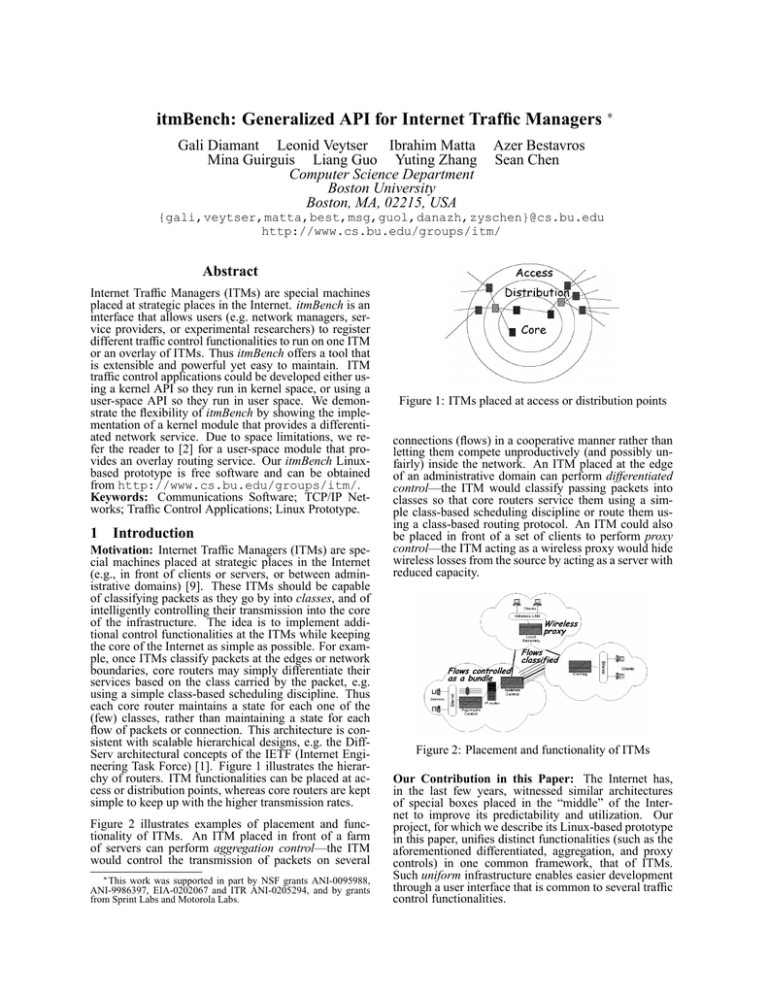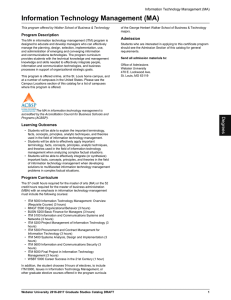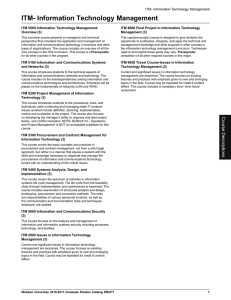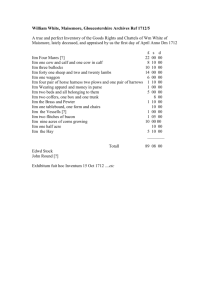itmBench: Generalized API for Internet Traffic Managers Gali Diamant Leonid Veytser Ibrahim Matta
advertisement

itmBench: Generalized API for Internet Traffic Managers ∗
Gali Diamant Leonid Veytser Ibrahim Matta
Mina Guirguis Liang Guo Yuting Zhang
Computer Science Department
Boston University
Boston, MA, 02215, USA
Azer Bestavros
Sean Chen
{gali,veytser,matta,best,msg,guol,danazh,zyschen}@cs.bu.edu
http://www.cs.bu.edu/groups/itm/
Abstract
Internet Traffic Managers (ITMs) are special machines
placed at strategic places in the Internet. itmBench is an
interface that allows users (e.g. network managers, service providers, or experimental researchers) to register
different traffic control functionalities to run on one ITM
or an overlay of ITMs. Thus itmBench offers a tool that
is extensible and powerful yet easy to maintain. ITM
traffic control applications could be developed either using a kernel API so they run in kernel space, or using a
user-space API so they run in user space. We demonstrate the flexibility of itmBench by showing the implementation of a kernel module that provides a differentiated network service. Due to space limitations, we refer the reader to [2] for a user-space module that provides an overlay routing service. Our itmBench Linuxbased prototype is free software and can be obtained
from http://www.cs.bu.edu/groups/itm/.
Keywords: Communications Software; TCP/IP Networks; Traffic Control Applications; Linux Prototype.
1
Introduction
Motivation: Internet Traffic Managers (ITMs) are special machines placed at strategic places in the Internet
(e.g., in front of clients or servers, or between administrative domains) [9]. These ITMs should be capable
of classifying packets as they go by into classes, and of
intelligently controlling their transmission into the core
of the infrastructure. The idea is to implement additional control functionalities at the ITMs while keeping
the core of the Internet as simple as possible. For example, once ITMs classify packets at the edges or network
boundaries, core routers may simply differentiate their
services based on the class carried by the packet, e.g.
using a simple class-based scheduling discipline. Thus
each core router maintains a state for each one of the
(few) classes, rather than maintaining a state for each
flow of packets or connection. This architecture is consistent with scalable hierarchical designs, e.g. the DiffServ architectural concepts of the IETF (Internet Engineering Task Force) [1]. Figure 1 illustrates the hierarchy of routers. ITM functionalities can be placed at access or distribution points, whereas core routers are kept
simple to keep up with the higher transmission rates.
Figure 2 illustrates examples of placement and functionality of ITMs. An ITM placed in front of a farm
of servers can perform aggregation control—the ITM
would control the transmission of packets on several
∗ This work was supported in part by NSF grants ANI-0095988,
ANI-9986397, EIA-0202067 and ITR ANI-0205294, and by grants
from Sprint Labs and Motorola Labs.
Figure 1: ITMs placed at access or distribution points
connections (flows) in a cooperative manner rather than
letting them compete unproductively (and possibly unfairly) inside the network. An ITM placed at the edge
of an administrative domain can perform differentiated
control—the ITM would classify passing packets into
classes so that core routers service them using a simple class-based scheduling discipline or route them using a class-based routing protocol. An ITM could also
be placed in front of a set of clients to perform proxy
control—the ITM acting as a wireless proxy would hide
wireless losses from the source by acting as a server with
reduced capacity.
Figure 2: Placement and functionality of ITMs
Our Contribution in this Paper: The Internet has,
in the last few years, witnessed similar architectures
of special boxes placed in the “middle” of the Internet to improve its predictability and utilization. Our
project, for which we describe its Linux-based prototype
in this paper, unifies distinct functionalities (such as the
aforementioned differentiated, aggregation, and proxy
controls) in one common framework, that of ITMs.
Such uniform infrastructure enables easier development
through a user interface that is common to several traffic
control functionalities.
The design of an ITM supporting those traffic management functionalities is based on a unified controltheoretic framework. Figure 3 shows the general architecture of an ITM. Typical of closed-loop feedback
control systems, the ITM would consist of control programs implementing the considered functionalities. The
parameters of these control programs would be dynamically adjusted based on measurements, e.g. the characteristics of the bottleneck resource such as its bandwidth
and buffer space. In this project, we focus on the management of traffic from the Transmission Control Protocol (TCP) since the majority of bytes on the Internet (up
to 95%) is attributed to TCP [10]. However, our generalized Application Programming Interface (API) we
present in this paper can support TCP-based as well as
non-TCP-based network services.
Specifically, through our itmBench API, ITM traffic
control applications could be developed on one ITM
or across an overlay of ITMs, either using a kernel
API so they run in kernel space, or using a user-space
API so they run in user space. Using an overlay of
ITMs provides a scalable solution to managing traffic,
especially across large-scale highly heterogeneous internets [3]. We demonstrate the flexibility of our itmBench API by showing the implementation of a kernel module that provides a differentiated network service. Due to space limitations, we refer the reader
to [2] for a user-space module that provides an overlay routing service. Our itmBench Linux-based prototype is free software and can be obtained from http:
//www.cs.bu.edu/groups/itm/.
Figure 3: General architecture of an ITM
utility. Netfilter [11], now part of the Linux kernel, was
originally a Firewall software, and now provides packet
filtering capabilites, using specific control tools.
After a thorough investigation of these systems, they
turned out to be inadequate for our needs. Click and
XORP deal with the core routing software itself, and focus on network protocols and their development through
a rudimentary interface. Netfilter only provides packet
filtering at different levels, but does not provide other
functionalities. ITMs are different, as they don’t handle core routing but rather provide a generalized infrastructure that allows different traffic control capabilities
to reside in the same machine, and be controlled using a
similar interface. This API supports the development of
control programs as either kernel-level modules or userspace modules. A unique goal of our itmBench API design is to also support traffic management functionalities
that span multiple ITM boxes, for example as in an overlay routing service or a virtual tunnel service.
3 Architecture
3.1 Overview
Applications (both kernel and user level) wishing to use
the ITM need to register with a core kernel module. This
module, called itm mod, keeps track of registered applications, and forwards packets to them according to their
specifications.
A control utility enables adding kernel modules and
user-level modules, each can be turned on or off according to need. This design results in a system that is:
• Extensible: Adding and removing capabilities is
easily done simply by loading only wanted modules;
• Easy to deploy: The architecture does not require
recompiling the kernel, making it simple to use.
UserApp 1
UserApp 2
libitm
libitm
Packets
Paper Outline: The remainder of this paper is organized as follows. Section 2 describes related work. Section 3 gives an overview of our ITM architecture. Section 4 describes in more detail the kernel-level itmBench
API, i.e. the interface that allows a user to develop a traffic control application in kernel space. Section 5 gives
an example kernel-level application, called qos mod. In
this application, the ITM classifies passing packets into
short-flow and long-flow classes, so short-flow packets are preferentially treated inside the network. Section 6 presents an overview of the itmBench API for
writing user-space applications, and describes itmRoute,
an overlay routing application built using the user-space
API. We refer the reader to [2] for more details. Finally,
Section 7 concludes the paper.
2
Related work
A few other projects have implemented extensible router
systems: Click [8] is a software for building modular
routers. XORP [6] is a routing infrastructure that provides an extensible experimental protocol deployment
User Space
Kernel
itm_queue
KernelApp2
itm_mod
Registration
KernelApp1
Figure 4: The ITM architecture
The ITM kernel module, itm mod, communicates with
the TCP/IP stack to retrieve packets. Both kernel-level
and user-level modules register with the ITM module. In
addition, user-level modules register with another kernel
module, called itm queue, which handles packets that
need to move to user space; it demultiplexes the packets and forwards them to the appropriate user-level (traffic control) applications. Figure 4 shows the different
components and connections between them. Applications (i.e. traffic control programs) can modify the packets, or leave them unchanged. They can claim the packets, causing them to drop, or reinject them to the TCP/IP
stack, to be processed as normal.
3.2
An Event-Driven System
We chose to implement an event-driven Application Programming Interface (API), where for each event, a set of
functions is defined. Users have to provide pointers to
the functions, to be called when the event is triggered.
The following five functions are currently supported:
• a classification function that specifies how to identify a class of packets or flows;
• a logging function that specifies how to log data and
update class structures;
• a processing function that determines the action(s)
associated with each event;
• a class-update function which defines how a class
should be updated based on the logged data; and
• a controller-update function which allows for updating the controller parameters based on measured
system state.
These functions are all called in this order, when the
event an application registered for occurs. Events can
be either synchronous (e.g. packet arrival at a specific
layer) or asynchronous (e.g. periodic). Our API currently uses Linux kernel modules to enable different capabilities. Our current implementation was tested on
both Linux 2.4.9 and Linux 2.4.20. Our current implementation requires netfilter to be installed as well, but
since this is now part of the Linux kernel, it is very
likely that netfilter is already installed on newer Linux
machines.
4
Kernel Space itmBench API
The ITM module, itm mod, is a Linux kernel module
which serves as an intermediate layer between the Linux
kernel and (traffic control) applications. It currently uses
netfilter to capture packets that travel the TCP/IP stack,
but this can be changed to work with any tool that provides similar capabilities. The ITM module needs to
be loaded before any others can be used, as it provides
them with necessary packet filtering capabilities, currently through netfilter. Thus, the ITM module actually
hides the details of netfilter from the users. Also, if we
ever decide to change the underlying layer and use a tool
other than netfilter, only this itm mod module will have
to be re-designed, avoiding a painful process of updating
many other modules.
Using netfilter hooks at the IP layer (where they are
currently available), we can intercept each packet at each
of five locations: pre-routing, IP-in, IP-forward, postrouting and IP-out. Figure 5 shows the relative location
of these interception points during the routing process.
The first parameter is the location in the TCP/IP stack
at which to intercept the packets. The itm info structure contains five pointers to functions (described in Section 3.2) and an identifying label for the registering module.
Figure 6 shows the members of the itm info structure.
Note that class func() needs to return a value, which
is later passed (as second argument) to process func().
This value is the class into which the classification
function classified this packet. If this value is 0, process func() will not be called.
The ITM module also allows for the registration of a
timer: an event to occur at specified intervals. This is
done using the following function:
itm register timer (void (*f)(unsigned long), int timeout)
that will result in the function f() being called periodically, every timeout jiffies.
Also provided are the functions itm unregister hook()
and itm unregister timer(), that need to be called when
those services are no longer needed, or when the module
is unloaded.
5
Application: Size-aware Differentiation
In this section, we use the itmBench API to implement
the size-aware scheduling of TCP flows [5] as a kernellevel application.
Motivation: Scheduling policies that give preference
to short (small) jobs, such as Shortest Job First (SJF)
and Shortest Remaining Processing Time (SRPT) first
scheduling, are long-known to be beneficial in reducing
the mean response time of the system. Since the delivery
of Internet documents can be viewed as an instance of
the job scheduling problem, it has recently been shown
that giving high priority to the transfer of small sized
TCP flows is also beneficial. This differentiated service
to different classes of TCP flows is provided simply by
changing a field in the IP header of a passing packet. For
a two-class service (i.e. short flows and long flows), an
edge/boundary router (the ITM) starts marking packets
of a flow as a “long-lived” TCP flow once the number
of packets of that flow reaches a predetermined threshold. These marked packets are then treated with lower
priority inside the network. This differentiated service is
illustrated in Figure 7.
TCP/IP stack
IP_IN
(2)
Pre-Route
(1)
(Route)
IP_OUT
(4)
IP Forward
(3)
Post-Route
(5)
Figure 5: IP hook points
Applications that wish to use the itm mod module need
to register at the wanted point, giving the criteria for “interesting” packets (according to flow information, protocol, etc.) Registration for a stack-related event is made
using the following function:
itm register hook(where location, itm info *data)
Figure 7: Classification of packets into short-flow and
long-flow classes
Implementation using the Kernel Space itmBench
API: The ITM maintains a counter for each flow, recording how many packets have been transmitted so far.
By default, packets from every new flow obtain the
highest priority. However, once this counter exceeds
some pre-defined threshold, the priority of the remaining packets is reduced to the next lower level (as the
flow to which these packets belong is now considered
typedef struct itm_info_t{
char *label;
itm_type type;
itm_interest interest;
pid_t pid;
where hook;
/*ITM_USER or ITM_KERNEL*/
/*has classification of "interesting" packets*/
/*ITM_USER pid*/
#ifdef __KERNEL__
/*ITM_KERNEL functions */
int (*class_func)(where, struct sk_buff **);
void (*log_func)(where, struct sk_buff **);
int (*process_func)(where, int, struct sk_buff **);
int (*update_func)(where, struct sk_buff **);
int (*control_func)(where, struct sk_buff **);
#else
/*ITM_USER functions */
int (*class_func)(where, ipq_packet_msg_t *);
void (*log_func)(where, ipq_packet_msg_t *);
int (*process_func)(where, int, ipq_packet_msg_t *);
int (*update_func)(where, ipq_packet_msg_t *);
int (*control_func)(where, ipq_packet_msg_t *);
#endif
} itm_info;
Figure 6: The itm info struct
long/large). Packet classification is accomplished by
tagging a TOS (Type-of-Service) field, or DiffServ Code
Point, in the packet header.
We implemented this differentiated functionality as
a kernel module, qos mod, using our itmBench API.
Henceforth, we show code segments to demonstrate the
use of the API.
qos mod uses a table to keep track of TCP
connections, identified by source+destination details
(ipaddr+port). It counts the number of packets per flow
and stores this value in the table entry which correponds
to the connection. Using these counters, qos mod classifies flows into LONG and SHORT according to the number of packets seen so far. A threshold value is given as
a parameter when the module is loaded (using insmod),
with a default value defined.
The first step is to register with itm mod, when the
module is loaded. Figure 8 shows how this is done in the
module’s init section. The code shows how to define
the classification, logging and processing functions, and
how to register with itm mod asking for packets in the
IP POST ROUTE stage of the TCP/IP stack. The module does not use the other two functions, class-update
and controller-update, so NULL pointers are passed.
Figure 9 shows the code for the classification function. Note that all the function does is to look at the current data logged and decide whether the flow is LONG,
SHORT or still unknown, according to the number of
packets seen so far.
The log function shown in Figure 10 either creates a
new entry in the flows table or increments the number of
packets seen for an existing flow.
Figure 11 shows code for the processing function. It is
called with a packet and its class (as was determined by
classify()). The TOS field in the IP header holds values
that are the logical AND of the following:
Normal-Service
Minimize-Cost
Maximize-Reliability
Maximize-Throughput
Minimize-Delay
0x00
0x02
0x04
0x08
0x10
If the class of a packet is known (LONG or SHORT), the
TOS field in its IP header is set so that a short flow will
have the Minimize-Delay bit on, while for a long flow
this bit is turned off. The default TOS value is defined
in the qos mod module as 0x10, so the first few packets
of a new flow are given a low-delay service under the
presumption that the flow is short.
Note that if the packet is modified, its IP checksum
needs to be recalculated. We also need to notify netfilter
of the change. The return value of NF ACCEPT results
in injecting the packet back to the place it was taken from
(IP POST ROUTE in this case) in the TCP/IP stack.
6
User Space itmBench API
The itmBench API supports the dynamic loading of
kernel-level modules (such as qos mod described in Section 5) as well as user-space modules. Even though kernel (traffic control) applications excel in performance,
they lack the flexibility and ease of implementation of
user-space programs. The itmBench API infrastructure
provides user-space access to captured packets to allow
any application in user space to register with the ITM
module and use all of the same services provided to kernel modules.
The user-space API is designed to be as close as possible to the kernel API—All the API functions and the
registration functions are preserved with the same names
and similar parameters. Referring to Figure 4, the implementation involves a kernel module, called itm queue,
and a user-space library, called libitm. The libitm library takes care of registration and packet transport, so
all what the user application needs to do is to provide the
implementation of the API functions (cf. Section 3.2).
itm_info data;
data.class_func = classify;
data.log_func = log;
data.process_func = process;
data.update_func = NULL;
data.control_func = NULL;
data.label = "qos_ctrl";
itm_register_hook(IP_POST_ROUTE, &data);
Figure 8: Using itm register hook()
int classify(where location, struct sk_buff **pskb)
{
int class = 0; // unknown
// look for connection in table, according to src+dst info
if (found)
{
// mark packet as short if haven’t seen too many
// packets of this flow or if it’s ending
// otherwise, it’s a long flow.
if ((con->pkt_cnt <= THRESHOLD) || (tcph->fin))
class = SHORT;
else class = LONG;
}
return class;
}
Figure 9: Sample classify func() code
void log(where location, struct sk_buff **pskb)
{
// look for connection in table, according to src+dst info
if (found)
{
// if still haven’t reached the threshold,
// need to keep counting
if (con->pkt_cnt <= THRESHOLD)
{
(con->pkt_cnt) ++;
}
}
else
{
// a new connection - add to table and start counter
con = add_new_connection()
con->pkt_cnt = 0;
}
}
Figure 10: Sample log func() code
We refer the reader to [2] for a detailed description of
the implementation of the user-space API and how ITM
applications can use this API to perform various traffic
control functionalities in user space. We briefly mention
here such application.
Application: Overlay Routing - A user-space overlay
routing application, we call itmRoute, has been written
using the user-space itmBench API and the libitm library.
It works by listening to packets that are leaving the machine and tunneling them through the “closest” neigh-
boring machine. The closeness of a neighbor is determined by sending small probe packets to the destination
tunneled through each neighbor. The destination machine would then reply with an acknowledgment. The
fastest received acknowledgment determines the “closest” neighbor. The status of a “closest” neighbor is refreshed periodically.
int process(where location, int class, struct sk_buff **pskb)
{
if (class == 0)
return NF_ACCEPT;
// if a long flow, need to unset the Minimize-Delay bit
if ((class == LONG) && (iph->tos & TOS))
iph->tos = (iph->tos & IPTOS_PREC_MASK) & ˜(TOS);
// otherwise - short flow, so need to set Minimize-Delay bit
else if ((class == SHORT) && (!(iph->tos & TOS)))
iph->tos = (iph->tos & IPTOS_PREC_MASK) | TOS;
// recalculate checksum!
// mark the packet as changed - needed by netfilter
(*pskb)->nfcache |= NFC_ALTERED;
return NF_ACCEPT;
}
Figure 11: Sample process func() code
7
Conclusion
In this paper, the ITM infrastructure has been presented
along with kernel-level and user-space traffic control applications written on top of it. We have presented code
segments for a kernel-level differentiated service. We
refer the reader to [2] for the implementation of a userspace overlay routing service. Yet another kernel-level
traffic control application, the elastic-tunnel service [4],
is currently under development using our itmBench API.
The elastic-tunnel framework [4] provides soft bandwidth guarantees by establishing a virtual pipe made of
as many as needed “coordinated” TCP connections between a source and a destination.
Our goal is to validate the flexibility and extensibility of our itmBench API design by developing a wide
range of traffic management applications. We intend to
provide a basic library so potential users will not have
to start from scratch when writing new applications, but
rather use a given set of basic capabilities.
Currently the list of registered modules (traffic control applications) is maintained as a simple FIFO queue.
We intend to allow the registering application to specify
its priority, so it can process packets of “interest” in a
possibly non-FIFO order. This issue is part of our larger
research agenda on the composition of larger traffic control applications from smaller ones. For example, a user
might want differentiated service inside an aggregated
virtual tunnel between two ITM boxes.
Finally, we intend to use our itmBench over PlanetLab [12] so as to experiment with new overlay traffic
management solutions.
8
Availability
Our ITM prototype is free software, available from
http://cs.bu.edu/groups/itm. This work is
a product of the Internet Traffic Managers project at
the Computer Science Department of Boston University.
This project is funded in part by the National Science
Foundation under grant ANI-0095988 from the Special
Projects in Networking program.
A related project that extends the itmBench programming framework to Internet applications other than traffic management and control can be found at http:
//cs.bu.edu/groups/ibench. This project is
funded in part by the National Science Foundation under grant ITR ANI-0205294.
Acknowledgment: We would like to thank Rich West
for his feedback.
References
[1] S. Blake, D. Black, M. Carlson, E. Davies, Z.Wang, and
W. Weiss. “An Architecture for Differentiated Services.” IETF
RFC 2475, December 1998.
[2] Gali Diamant, Leonid Veytser, Ibrahim Matta, Azer Bestavros,
Mina Guirguis, Liang Guo, Yuting Zhang, Sean Chen.
“itmBench: Generalized API for Internet Traffic Managers,” Technical Report BUCS-2003-032, Computer Science Department, Boston University, December 16, 2003.
http://www.cs.bu.edu/techreports/
[3] K. Fall. “A Delay Tolerant Networking Architecture for Challenged Internets.” In Proceedings of ACM SIGCOMM 2003, August 2003.
[4] Mina Guirguis, Azer Bestavros, Ibrahim Matta, Niky Riga, Gali
Diamant, Yuting Zhang. “Providing Soft Bandwidth Guarantees
Using Elastic TCP-based Tunnels,” Technical Report BUCS2003-028, Computer Science Department, Boston University,
December 2, 2003. http://www.cs.bu.edu/techreports/ To appear
in IEEE ISCC 2004.
[5] Liang Guo and Ibrahim Matta. “The War between Mice and Elephants.” In Proceedings of ICNP’2001: The 9th IEEE International Conference on Network Protocols, Riverside, CA, November 2001. http://www.cs.bu.edu/groups/itm/SATS/
[6] Mark Handley, Orion Hodson, and Eddie Kohler, “XORP: An
Open Platform for Network Research.” http://www.xorp.org.
[7] The ITM project web site, http://www.cs.bu.edu/groups/itm.
[8] Eddie Kohler, Robert Morris, Benjie Chen, John Jannotti, and
M. Frans Kaashoek, “The Click modular router,” ACM Transactions on Computer Systems, 18(3), August 2000, pages 263-297.
http://www.pdos.lcs.mit.edu/click/
[9] Ibrahim Matta and Azer Bestavros. “QoS Controllers for the Internet.” In Proceedings of the NSF Workshop on Information
Technology, March 2000.
[10] Measurement Studies of End-to-End Congestion Control in the
Internet. http://www.icir.org/floyd/ccmeasure.html.
[11] The netfilter/iptables project, http://www.netfilter.org.
[12] The Planet-Lab project, www.planet-lab.org.




